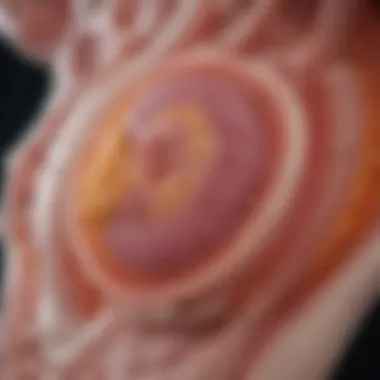Gastric Motility: Mechanisms and Health Implications


Intro
Gastric motility plays a pivotal role in the digestive process, influencing how food is processed and absorbed within the body. Understanding this complex physiological phenomenon is essential for grasping the dynamics of overall digestive health. This article aims to delve into both the mechanisms that govern gastric motility and the broader implications that arise from alterations in motility patterns. To appreciate these complexities, it is vital to examine the intricate processes involved, consider relevant research, and explore how lifestyle choices impact gastric function.
Overview of Research Topic
Brief Background and Context
Gastric motility refers to the contractions of the muscular walls of the stomach that facilitate the mixing and propulsion of food. This process is highly regulated and involves a series of coordinated activities that ensure effective digestion and optimal nutrient absorption. The primary components of gastric motility include peristalsis, which is the wave-like contractions that move food through the digestive tract, and mixing movements that break down food particles further.
A better comprehension of gastric motility yields insights into various gastrointestinal disorders such as gastroparesis and functional dyspepsia. The implications extend not only to clinical settings but also to everyday life, as various factors such as diet, stress, and lifestyle choices can significantly affect these motility patterns.
Importance in Current Scientific Landscape
Understanding gastric motility is becoming increasingly crucial in the realm of digestive health. Research continues to highlight its implications for various medical conditions and the overall impact on well-being. The increasing prevalence of motility disorders underscores the need for a deeper understanding of the mechanisms behind this physiological process. Trends in dietary habits also reflect a need to investigate how changes in lifestyle may contribute to gastrointestinal health.
"Gastric motility serves as a foundation for digestive health, and its dysfunction can lead to significant health challenges."
This exploration of gastric motility will link scholarly research with practical implications, providing valuable insights for educators, students, researchers, and healthcare professionals.
Methodology
Research Design and Approach
This article synthesizes existing research literature, including empirical studies, reviews, and meta-analyses. The focus is on elucidating both the physiological processes underlying gastric motility and the conditions associated with its dysfunction. This hybrid approach allows for a comprehensive understanding, bridging basic science with applied health considerations.
Data Collection Techniques
Data collection for this analysis is drawn from multiple reputable sources, including recent findings published in peer-reviewed journals and prominent healthcare databases. This cross-referencing ensures a well-rounded perspective on gastric motility and its health implications. The insights derived will also take into account new research trends and findings that illustrate the dynamic nature of this field.
By examining both historical data and the latest studies, a clearer picture of gastric motility emerges, illustrating its significance in the study of human health.
Gastric Motility: An Overview
Gastric motility refers to the contractions of the stomach muscles that move food through the digestive system. Understanding its mechanisms and implications is necessary, as it affects not just food processing but overall health.
The importance of this topic lies in its role within the larger digestive framework. Efficient gastric motility is crucial for breaking down food, mixing it with digestive juices, and ensuring that nutrients are absorbed effectively. This process influences how well the body can utilize what it consumes. Additionally, disturbances in gastric motility can lead to various gastrointestinal disorders, affecting quality of life and nutrition.
Definition of Gastric Motility
Gastric motility involves a series of coordinated muscular contractions in the stomach. These are primarily classified into three types: peristalsis, segmentation, and retropulsion. Peristalsis is the smooth muscle contraction that propels the contents through the digestive tract. Segmentation refers to the contraction and relaxation of circular muscles in the stomach, which helps mix food. Finally, retropulsion occurs when food is pushed back toward the stomach for further breakdown.
Understanding gastric motility is essential for medical professionals and researchers since it serves as a basis for diagnosing various digestive disorders. Any interruption in these rhythmic motions can indicate underlying health issues.
Importance in Digestion
The importance of gastric motility in digestion cannot be overstated. Here are some key points:
- Efficient Food Breakdown: The contractions help break down food into smaller particles. This is critical for later absorption in the intestines.
- Mixing with Digestive Juices: As food moves, it is mixed with gastric acids and enzymes, fostering an optimal environment for digestion.
- Regulating Emptying: Gastric motility plays a key role in gastric emptying, ensuring that food moves into the small intestine in a timely manner.
In summary, without effective gastric motility, the process of digesting food becomes inefficient. This can lead to issues such as nutrient deficiencies, indigestion, and other gastrointestinal disorders.
"Understanding gastric motility is crucial for medical professionals and researchers, as it serves as a basis for diagnosing various digestive disorders."
The Mechanisms of Gastric Motility


Understanding the mechanisms of gastric motility is crucial for grasping how our digestive system functions. This section outlines the anatomy of the stomach and the various types of motility that occur within it. Exploring these mechanisms provides insight into how food is processed and moved through the gastrointestinal tract.
Anatomy of the Stomach
The stomach is a complex organ, functioning as a reservoir and mixer for food. It has four primary regions: the cardia, fundus, body, and pylorus. Each section plays a specific role in digestive mechanics. The inner lining is lined with gastric mucosa, which contains glands that secrete digestive juices.
Key components include:
- Sphincters: The lower esophageal sphincter prevents reflux, while the pyloric sphincter regulates food passage to the small intestine.
- Muscle Layers: The stomach has three muscle layers: the outer longitudinal, middle circular, and inner oblique muscles. This structure facilitates various movements critical for food mixing.
- Blood Supply and Nerve Innervation: The stomach receives blood from the celiac trunk and has extensive innervation from the vagus nerve, essential for regulating motility and secretions.
These anatomical features enable the stomach to perform its functions effectively, highlighting the relationship between structure and motility.
Types of Motility
Gastric motility involves several types of movements that play distinct yet interrelated roles in digestion. The primary types of gastric motility include peristalsis, segmentation, and retropulsion.
Peristalsis
Peristalsis is a wave-like muscle contraction that moves food down the gastrointestinal tract. Its key characteristic is the rhythmic contraction of the muscle layers in the stomach. This type of motility is particularly beneficial for transporting food from the stomach to the intestines.
A unique feature of peristalsis is its coordination with circular and longitudinal muscle fibers, ensuring smooth movement of the chyme. It allows for the effective mixing of gastric juices with food, which enhances nutrient breakdown, though its speed can vary.
Segmentation
Segmentation involves localized contractions in the intestinal wall, particularly in the small intestine and proximal large intestine. The primary function of segmentation is to mix and break down food, facilitating absorption of nutrients. Its key characteristic is the constriction of circular muscles that segment food into smaller pieces.
This motility offers an advantage by enhancing nutrient contact with the absorptive surfaces of the intestinal lining. However, it is less effective for propelling contents forward when compared to peristalsis.
Retropulsion
Retropulsion occurs when food is pushed backward in the stomach. This motion results from the contraction of the pyloric sphincter, causing food to move back toward the stomach body. The key characteristic of retropulsion is its role in grinding solid food into smaller particles, facilitating breakdown.
This type of motility is particularly advantageous for ensuring that larger particles are pulverized adequately before proceeding to the intestine. However, excessive retropulsion can lead to delays in gastric emptying, contributing to digestive discomfort.
Understanding these mechanisms of gastric motility is crucial as they reflect the functional and physiological demands placed on the digestive system. They are important not only for digestion but also for the overall health of the gastrointestinal tract.
Regulation of Gastric Motility
Gastric motility requires precise regulation for optimal functioning of the digestive system. Understanding this regulation has both clinical and practical significance. It affects how food is mixed, broken down, and propelled through the gastrointestinal tract. Anomalies in gastric motility can lead to various disorders, influencing both nutritional absorption and overall health.
Neurogenic Regulation
The nervous system plays a crucial role in regulating gastric motility. The enteric nervous system, often referred to as the "second brain" of the gut, communicates with the central nervous system to coordinate digestive functions. Neurotransmitters such as acetylcholine excite smooth muscle contractions which enhance peristalsis, the wave-like movement that propels food.
Additionally, reflexes involving vagus nerve contribute significantly to gastric motility regulation. Stimulation of the vagus nerve can lead to increased gastric acid secretion and motility, allowing efficient food processing. Conversely, stress can activate the sympathetic nervous system, inhibiting motility. This relationship highlights the complex interplay between emotional state and digestive health.
The study of neurogenic regulation is important for developing treatments for motility disorders. For instance, understanding how different neurotransmitters influence gut movement can lead to targeted therapies.
Hormonal Influences
Hormones also significantly impact gastric motility. Various hormones, such as gastrin, secretin, and cholecystokinin, are released based on food intake. Gastrin, released by G cells in the stomach lining, stimulates gastric motility and secretion of gastric acid. Increased gastric acid aids in the breakdown of food and prepares it for digestion in the small intestine.
Cholecystokinin, released by intestinal cells when fatty food enters the small intestine, slows gastric emptying. This delay allows more time for digestion and nutrient absorption. Secretin, on the other hand, regulates the secretion of bicarbonate, ensuring optimal pH levels in the intestine.
Recognizing the role of hormones in gastric motility is essential. It sheds light on the potential for interventions that can adjust these hormonal responses in cases of disorders such as gastroparesis.


Effective regulation of gastric motility relies on a harmonious interaction between neural and hormonal signals, which is fundamental for digestion.
In summary, the regulation of gastric motility is a sophisticated process that involves neurogenic and hormonal influences. Understanding this regulation can provide vital insights into digestive health and guide therapeutic strategies for motility disorders. Awareness of these mechanisms can help in making informed lifestyle and dietary choices, contributing to better overall health.
Physiological Significance of Gastric Motility
Gastric motility serves as a vital component in the digestive process, enabling the stomach to perform its roles efficiently. Understanding the significance of gastric motility is essential, as it directly influences both nutrient absorption and gastric emptying. In essence, the physiological importance of this process lies in its ability to regulate the movement and breakdown of food, ensuring that the body receives the necessary nutrients required for optimal function.
Nutrient Absorption
The absorption of nutrients is one of the primary functions influenced by gastric motility. As food enters the stomach, various mechanisms of motility come into play. The stomach not only churns food into smaller particles but also mixes it with gastric juices. This combines mechanical breakdown with chemical digestion. The partially digested food, known as chyme, is then gradually released into the small intestine where most nutrient absorption occurs.
When gastric motility is disrupted, it can impact how effectively nutrients are absorbed. For instance, if food passes too quickly through the stomach, there might not be enough time for it to mix adequately with digestive enzymes, leading to incomplete absorption. Conversely, if gastric emptying is delayed, it could result in discomfort and nausea due to prolonged distension of the stomach. Thus, optimal gastric motility is crucial for maximizing the availability of nutrients for absorption in the intestines.
Gastric Emptying
Gastric emptying is another critical aspect of digestive health closely linked to gastric motility. This process involves the regulated release of chyme from the stomach into the small intestine. The rate of gastric emptying is influenced by several factors, including the type of food consumed, hormonal signals, and the physical state of the stomach.
A well-coordinated gastric emptying process ensures that food is passed in manageable portions to the small intestine. Rapid gastric emptying can lead to a condition known as dumping syndrome, characterized by symptoms like diarrhea, nausea, and rapid fluctuations in blood sugar levels. On the other hand, delayed gastric emptying can result in gastroparesis, which is often seen in patients with diabetes. This condition can cause symptoms such as bloating, early satiety, and abdominal discomfort. Both situations underscore the need for proper gastric motility to maintain a balanced digestive process.
"The interplay between gastric motility, nutrient absorption, and gastric emptying is essential for overall digestive health."
Pathophysiology of Gastric Motility Disorders
Understanding the pathophysiology of gastric motility disorders is vital in comprehending how these conditions affect digestion and overall health. Gastric motility disorders can lead to disruptions in the normal movement of food throughout the digestive system, impacting nutrient absorption and patient well-being. These disorders often arise from either structural abnormalities or functional issues within the gastric system. The importance of recognizing these disorders lies in their potential to cause significant discomfort and complications, necessitating timely intervention for optimal management.
Types of Disorders
Gastric Emptying Disorders
Gastric emptying disorders are characterized by delayed gastric emptying, which can disrupt the normal digestion process. This condition is often assessed through tests that measure the rate at which food leaves the stomach. The key characteristic of gastric emptying disorders is their impact on patient quality of life. Symptoms may include nausea, bloating, and abdominal pain. These symptoms can be debilitating and require careful dietary management.
Gastric emptying disorders are of particular relevance in this article because they highlight how motility can affect the absorption of nutrients and overall digestive efficiency. A unique feature of this disorder is its association with other conditions, such as diabetes. Patients with diabetes may experience gastroparesis, a type of gastric emptying disorder.
Functional Dyspepsia
Functional dyspepsia refers to chronic upper abdominal discomfort with no identifiable cause. This disorder can significantly disrupt daily life and often leads to a reduced quality of life. Its significance in this article is due to the wide range of symptoms it presents, including feelings of fullness, nausea, and even heartburn. The underlying mechanism often relates to dysfunctional motility in the stomach.
The unique feature of functional dyspepsia is that it usually occurs with no visible physiological damage, making diagnosis challenging. Management focuses on dietary modifications and pharmacological approaches to alleviate symptoms.
Gastroparesis
Gastroparesis is another key disorder that falls under the umbrella of gastric motility impairments. It is defined as a delayed gastric emptying condition, where the stomach does not contract properly. The main characteristic of gastroparesis is the retention of food in the stomach, leading to various symptoms, including nausea, vomiting, and early satiety. Understanding this condition is beneficial for readers, as it raises awareness about how chronic gastric issues can influence other health problems.
Gastroparesis often complicates diabetes management and can lead to dehydration and nutritional deficiencies. This disorder has unique aspects, including the necessity for complex dietary adjustments to help manage symptoms effectively.
Symptoms and Diagnosis
When assessing gastric motility disorders, identifying the symptoms is essential. Patients may report various clinical signs that include nausea, vomiting, abdominal pain, and changes in appetite. Diagnosing these disorders typically involves patient history reviews, physical examinations, and specific tests such as gastric emptying studies.
The recognition of these disorders allows healthcare providers to offer tailored treatments that address individual patient needs. In understanding both the symptoms and the diagnostic procedures, one can gain insights into the complexities of gastric motility. Frequent monitoring and adjustment in treatment plans can significantly enhance patient outcomes.
Impact of Lifestyle on Gastric Motility
Gastric motility is not solely a physiological function. It is markedly influenced by external factors including lifestyle choices. Understanding this topic helps in identifying potential ways to optimize digestive health through conscious decisions. This section delves into how dietary habits and physical activity levels interplay with gastric motility, contributing to overall digestive efficiency and comfort.


Dietary Choices
Dietary choices play a critical role in regulating gastric motility. What we eat can directly impact how food is processed in the stomach and beyond. High-fiber diets, for instance, are known to enhance motility by promoting more efficient movement through the digestive tract. Foods such as whole grains, fruits, and vegetables can lead to increased bulk in the stomach, thereby stimulating peristalsis.
Conversely, diets rich in refined sugars and unhealthy fats may slow gastric motility, leading to discomfort and digestive disorders. High-fat meals can slow down the stomach emptying process, making one feel bloated or sluggish. It's also important to consider meal frequency and portion sizes. Smaller meals are generally easier to digest and can encourage regular gastric contractions, while large meals can overwhelm the stomach, leading to delays in emptying.
- Key points regarding dietary choices include:
- High-fiber foods enhance gastric emptying.
- Low-fiber and high-fat meals may slow motility.
- Smaller, more frequent meals can improve digestive efficiency.
Maintaining hydration levels is also crucial; adequate fluid intake can aid in the movement of food through the gastrointestinal tract.
Physical Activity Levels
Physical activity is another significant factor affecting gastric motility. Regular exercise is linked to improved digestive health. Activities such as walking or cycling can stimulate the muscles of the gastrointestinal tract, promoting effective gastric contractions and overall motility. Conversely, a sedentary lifestyle may contribute to sluggish digestion and constipation.
The type and intensity of exercise can also influence gastric motility. Moderate-intensity exercise tends to enhance motility, whereas engaging in intense activities immediately after meals could potentially lead to discomfort or even nausea. Finding a balance between exercise and digestion is vital.
"Engaging in consistent physical activity not only benefits overall health but also supports efficient gastric motility."
In evaluating physical activity levels, it is beneficial to consider:
- The relationship between exercise and motility:
- Regular activity promotes healthy digestion.
- Sedentary behavior may result in slower gastric transit times.
- Appropriate timing of exercise relative to meals can impact comfort and digestive performance.
By understanding and improving lifestyle choices related to diet and physical activity, individuals can enhance gastric motility and optimize their digestive health.
Recent Research Insights
Recent studies in the field of gastric motility have significantly broadened our understanding of this crucial aspect of the digestive process. Researchers continually explore various mechanisms, regulatory factors, and therapeutic options that impact gastric motility. This section presents both the advancements in our comprehension of gastric motility and the emerging treatments that promise to improve the quality of life for individuals with motility disorders.
Advancements in Understanding Motility
Recent advancements in technology have led to a more nuanced understanding of gastric motility. For example, high-resolution manometry now allows for detailed analysis of pressure patterns within the stomach. This method enables researchers to observe motility responses to different stimuli, providing insight into how food interacts with gastric walls. Furthermore, studies investigating the role of the gut microbiome show that bacteria in the gastrointestinal tract influence gastric motility. Their metabolic activities can either promote or hinder normal gastric contractions, highlighting the intricate link between microbiota and digestive health.
Research is also focusing on the neurophysiology of gastric motility. It has been discovered that enteric neurons, which are responsible for coordinating contractions, have distinct responses to various types of food. These findings could lead to tailored dietary recommendations based on an individual's specific motility patterns. As we deepen our knowledge through both clinical studies and animal models, the eye is set on unlocking new potential for diagnosis and prognostic tools in the realm of motility disorders.
Innovative Treatments and Interventions
The landscape of treatment options for gastric motility disorders is rapidly evolving as new research surfaces. Prokinetic agents, such as metoclopramide and domperidone, are frequently prescribed to enhance gastric emptying and improve overall motility function. However, recent research explores novel approaches, including the use of neuromodulators. These agents can adjust the activity of neural pathways associated with gastric contractions, providing an avenue for targeted therapeutic strategies.
In addition to pharmacological treatments, dietary interventions are also gaining notice. Certain foods can play a role in enhancing or impeding gastric motility. Therefore, collaborative studies between nutritionists and gastroenterologists are being encouraged to develop comprehensive management plans. Moreover, preliminary studies point to the potential of biofeedback techniques as a way to train patients to modulate their gastric function through mindful practices.
"Understanding the mechanisms of gastric motility not only enriches our knowledge but also opens the door for innovative treatment modalities that could change lives."
Overall, the integration of cutting-edge research with clinical applications marks a promising frontier in gastric motility therapy. As findings emerge, future studies will undoubtedly refine our approaches, optimizing treatment pathways that cater to individual patient needs.
The End
Understanding gastric motility is crucial in the broader context of digestive health. It encompasses a wide array of mechanisms that not only facilitate the movement of food through the stomach but also influence how well nutrients are absorbed by the body. The intricacies of this process are significant, and grasping these elements can help in managing various gastrointestinal issues.
Through this article, we have emphasized specific factors that affect gastric motility. These include not only the physiological aspects but also how lifestyle choices greatly impact the efficiency of this process. Diet, in particular, has a direct relationship with motility, affecting gastric emptying rates and overall digestive comfort. Furthermore, lifestyle considerations such as physical activity play a significant role. Increased movement enhances gastric emptying, aligning well with digestive efficiency.
Another important point is the identification of motility disorders. Understanding these conditions and their symptoms allows for timely diagnosis and treatment. The knowledge shared here forms a foundation for recognizing when something is amiss with one’s digestive health, prompting individuals to seek appropriate medical advice.
In recent years, research has shed light on innovative treatments and interventions designed to improve gastric motility, reflecting the ongoing efforts in the medical community. Such developments are beneficial as they provide hope and potential solutions for those affected by motility issues.
In summary, the article provides a cohesive overview of gastric motility, its mechanisms, implications, and impact of lifestyle choices. Enhanced understanding can lead to better health outcomes, making it a pertinent area of study for students, educators, and professionals alike.
"A thorough understanding of gastric motility not only clarifies physiological function but also equips individuals to make informed health choices."
Ultimately, this knowledge is essential for advancing digestive health and well-being.



